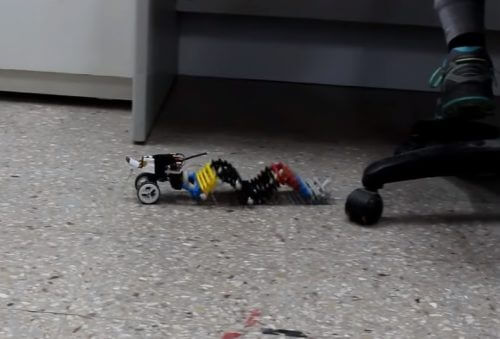"Although researchers all over the world have been trying to produce undulating motion for about 90 years, we were able to find a unique and simple solution" says Dr. David Zarok from Ben Gurion University, the developer of the robot

At Ben-Gurion University in the Negev, the world's first robot that produces pure undulating motion by using only one motor was developed. The SAW robot (Single Actuator Wave-like robot), is intended for medical purposes, maintenance, search and rescue and security.
The robot was developed by Dr. David Zarok, senior researcher in the mechanical engineering department, head of the laboratory for bio-robotics and medical robotics and active in the ABC ROBOTICS project at Ben-Gurion University of the Negev, who studies the movement of the robot, together with two master's students: Ilanit Waxman, who studies the subject of swimming in viscous fluids simulating movement of small biological organisms in swimming; Nir Daghani, who studies the movement of the robot on flexible surfaces with the aim of operating it inside the human body.
The robot is influenced by the movement of snakes in nature, but its undulating movement is carried out in a vertical direction. The undulating movement allows the robot to crawl on different surfaces, climb and also swim, when the wheels are for steering only. The robot develops a peak speed of 57 cm per second, 5 times faster than most robots of the same type. SAW is able to climb over obstacles and crawl over hard surfaces such as sand, grass and gravel. The robot can also climb inside canals, when it touches both sides of the canal and manages to climb at a speed of 8 cm per second. In addition to this, a waterproof version was built, which can swim at a speed of 6 cm per second.
Dr. Zarok: "Although researchers all over the world have been trying to produce undulating motion for about 90 years, we were able to find a unique and simple solution that makes it possible to produce the robot in different sizes for different purposes. For example, it can be enlarged for search and rescue purposes, in penetrating complex and problematic areas, such as piping, tunnels and ruins, or reduced to a diameter of about 1 cm or even less, in order to move it inside the human body for medical purposes, such as photography or taking biopsies within a system Digestion". "We received a strong robot, easy to manufacture, reliable and with low energy consumption, which allows it to move over long distances."
The development findings were recently published as a scientific article in the journal Bioinspiration & Biomimetics
A video demonstrating the operation of the robot developed by Dr. David Zaruk:

3 תגובות
Very beautiful and elegant. Well done!
Cannon
The idea is charming in its simplicity, but if they think that it can progress in the large intestine contrary to the natural direction of movement - they are in for a disappointment. The walls of the intestine are very smooth and all the means that have tried to use the force of friction to advance there have failed.